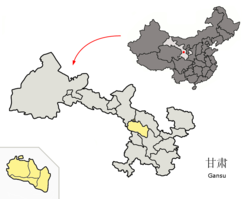Honggu, Lanzhou
Honggu
红古区 | |
|---|---|
 Location in Lanzhou | |
 Lanzhou in Gansu | |
| Country | China |
| Province | Gansu |
| Prefecture-level city | Lanzhou |
| Area | |
| • Total | 568 km2 (219 sq mi) |
| Highest elevation | 2,462 m (8,077 ft) |
| Lowest elevation | 1,580 m (5,180 ft) |
| Population (2019) | |
| • Total | 143,000 |
| • Density | 250/km2 (650/sq mi) |
| Time zone | UTC+8 (China Standard) |
| Postal code | 730084 |
| Website | www |
Honggu District (simplified Chinese: 红古区; traditional Chinese: 紅古區; pinyin: Hónggǔ Qū) is one of five districts of the prefecture-level city of Lanzhou, the capital of Gansu Province, Northwest China. Although administratively part of Lanzhou, it is not part of the continuous built-up area of the city, and is located roughly equidistant between Lanzhou and Xining. Directly across the Huangshui River lies Minhe Hui and Tu Autonomous County in Qinghai.[1]
The area of Honggu District has been inhabited since at least 5000 B.C. In 110 B.C., the area was captured by the Han dynasty army. In 1960, the district was split off from Xigu District, before then it had also been part of both Yongdeng County en Gaolan County.[2] Until 1989, the county seat was in Yaojie, nowadays, Haishiwan is the county seat. Since the districts urban centre and government is not located in the town Honggu, the district is often referred to by locals as Haishiwan or Yaojie.[3]
Honggu is rich in mineral resources such as coal, sand, gravel, petroleum, ores.[2] During the first five-year plan of the PRC (1953–1957), coal mining was developed in the area. In 2011 its mineral resources were declared exhausted.[4]
One of the first found Mamenchisaurus remains were found near Haishiwan in 1958.[5]
Administrative divisions
[edit]Honggu District is subdivided in 3 subdistricts and 4 towns,[6] 34 administrative villages and 22 residential communities.[2]
- Subdistricts
|
|
- Towns
|
|
See also
[edit]References
[edit]- ^ "【聚焦兰西城市群建设】一桥跨两省,一"通"百事兴 "川海大桥"将民和县与红古区连成一个整体-甘肃-每日甘肃网". gansu.gansudaily.com.cn. Retrieved 2021-04-10.
- ^ a b c "兰州市红古区政府网站 红古概况".
- ^ "人知兰州海石湾,不知"兰州红古区"_连城". www.sohu.com. Retrieved 2021-04-10.
- ^ 网易 (2018-01-05). "兰州红古区:智慧农业"花枝俏" 采煤沉陷区变公园". www.163.com. Retrieved 2021-04-10.
- ^ Young, C.C., and Zhao, X.-J. (1972). "Mamenchisaurus hochuanensissp. nov." Institute of Vertebrate Paleontology and Paleoanthropology Monographs, A, 8:1-30.
- ^ 2023年统计用区划代码和城乡划分代码:红古区 (in Simplified Chinese). National Bureau of Statistics of China.
36°21′06″N 102°52′57″E / 36.35167°N 102.88250°E
